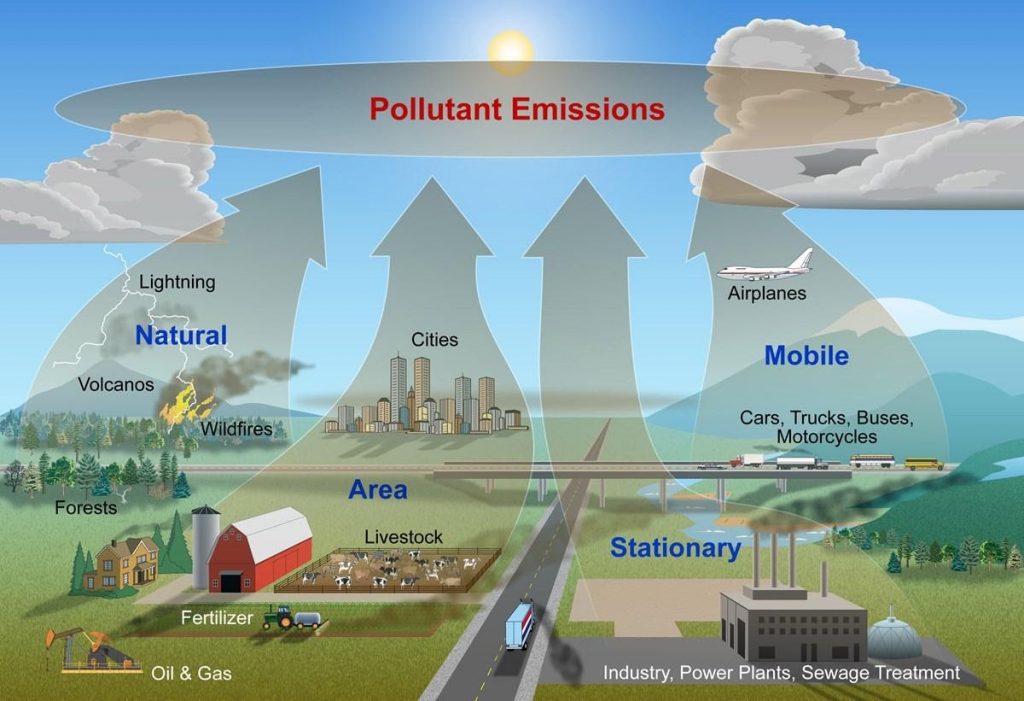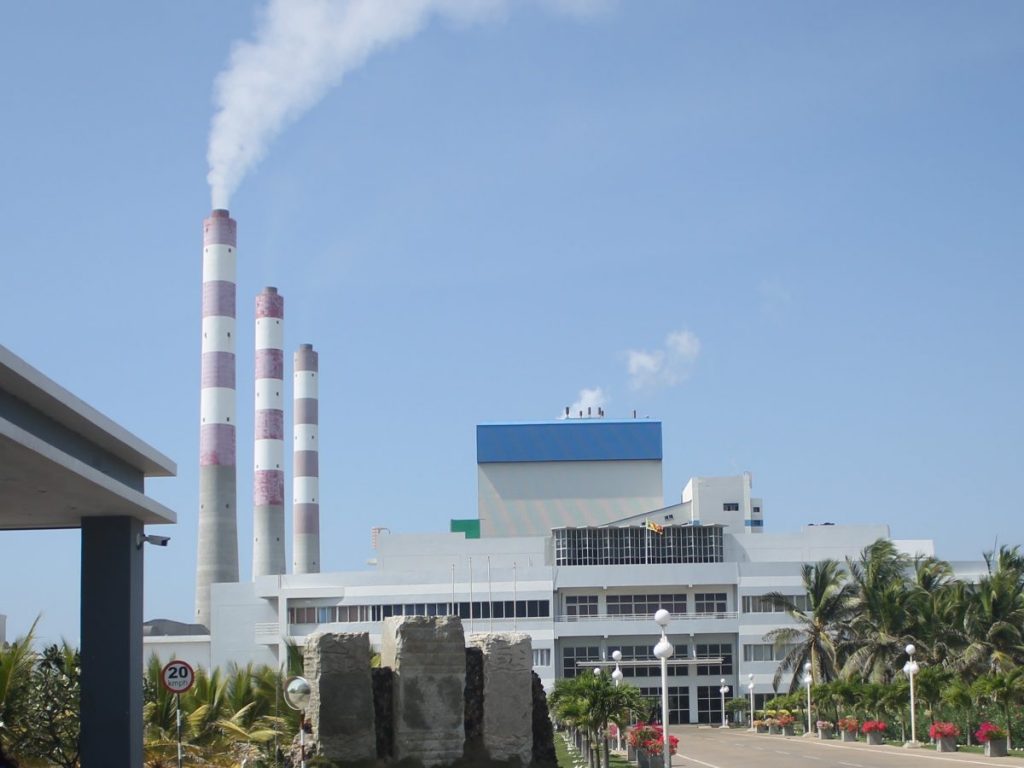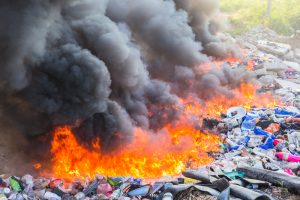Sources
of Air Pollution
Mobile | Stationary | Area | Natural
Air pollutants are emitted from a range of both man-made and natural sources and outdoor air pollution originates from them. There are four main types of air pollution sources;

- Mobile sources – such as cars, buses, planes, trucks, and trains
- Stationary sources – such as power plants, oil refineries, industrial facilities, and factories
- Area sources – such as agricultural areas, cities, and wood-burning fireplaces
- Natural sources – such as wind-blown dust, wildfires, and volcanoes
When it comes to Sri Lanka main sources of air pollution are:
Mobile Sources:
Trans-boundary pollutionAir pollution does not stop at national borders; thus, countries in the region are both sources and receptors, referred to as trans-boundary air pollution. This phenomenon is changing due to the wind patterns in different seasons. In the north-east monsoon wind brings pollution clouds from India and even China which are produced from power plants, industries and motor vehicles. The observed highest levels of pollution was November-January period and the air pollution levels are lowest during the south-west monsoon, since the winds come from the sea where there is no land mass to the south until Antarctica. The air pollution levels from March to October are relatively low in Sri Lanka and the air pollution levels show a noticeable seasonality.

Trends in energy consumption show increase in petroleum consumption compared with other renewable sources such as biofuels and hydropower. The country has also seen rapid motorization (e.g., doubling of the motor vehicle fleet in one decade from 1991 to 2000). Sri Lanka’s Ministry of Environment estimated in 2011 that emissions from motor vehicles account for 55-60% of air pollution, while 20-25% is due to industries and 20% is from domestic sources. The number of vehicles is rising and although recently emission testing has been mandated, the rise in emissions from 3-wheel auto-rickshaws has aggravated air quality, particularly in urban settings.
The major air pollutants from traffic congestion include carbon monoxide (CO), carbon dioxide (CO2), volatile organic compounds (VOCs) or hydrocarbons (HCs), inorganic compounds (Pb), nitrogen oxides (NOx), and particulate matter (PM).
Stationary Sources:
CoalA coal-fired power station or coal power plant is a thermal power station which burns coal to generate electricity. Coal-fired power stations generate over a third of the world’s electricity but cause hundreds of thousands of early deaths each year, mainly from air pollution.
Coal-fired power plants are the biggest industrial sources of mercury and arsenic in the air. Pollution from coal-fired power plants account for 81 percent of the electric power industry’s greenhouse gas emissions, including carbon dioxide. These plants also release smaller amounts of methane and nitrogen oxides.
Coal-fired power plants also emit:
- Cadmium
- Chromium
- Dioxins
- Formaldehyde
- Furans
- Hydrogen chloride
- Hydrogen fluoride
- Lead
- Nickel
- Particulate matter
- Polycyclic aromatic hydrocarbons (PAHs)
- Sulfur dioxide
- Volatile organic compounds (VOCs)
The main components of a coal power Plant (Image Source: https://en.wikipedia.org/wiki/Fossil_fuel_power_station)

Sri Lanka’s first coal fired thermal power plant and the largest power station is implemented as a venture of Ceylon Electricity Board with the aid of EXIM Bank of the Republic of China. Located 100m inland from the shoreline, the construction was undertaken by the CMEC (China Machinery Engineering Corporation) and the total estimated cost of the project was USD 1.35 billion. The contract for the project was singed in 2006 and the first phase of the power plant, 300 MW was commissioned in 2011. The second phase completed adding another 300 MW in 2014 while the third phase added another 300 MW, making the total power generated through the Norochcholai power plant 900 MW. The first phase also included the construction of a 115km transmission line that connected the power plant to the national grid through the Veyangoda substation. A jetty that extended 4.2km into the ocean was also constructed. Nearby villages include Narakkalli and Penaiyadi on the Kalpitiya peninsula.

A second coal power plant was proposed as a joint venture of Ceylon Electricity Board and National Thermal Power Corporation (NTPC) of India. The Joint Venture Company has been incorporated as Trincomalee Power Company Limited on 6th September 2011. Trincomalee Power Company Limited was expected to be responsible for the implementation and operation of the 2 X 250MW coal power plant in Sampur. The total estimated cost of the project was projected to be USD 512 Million.
The power generated will be transmitted to the national grid through high voltage transmission lines from Sampur through Habarana to the Veyangoda Grid Substations. A Power Purchase Agreement, Implementation Agreement, BOI Agreement, Land Lease Agreement and Coal Supply Agreement were signed on 07 October 2013 by the Government of Sri Lanka, Ceylon Electricity Board and JV Company. The project was expected to be commissioned before the end of 2017. However, due to flaws in its EIA in preventing environmental pollution, and objections from the public, the government decided to cease plans. This project though may be revived by a future government.
A cabinet proposal was submitted, seeking the approval of the Cabinet to authorize the CEB to construct a fourth unit of 300 MW as an extension of the Norochcholai Coal Power Plant, using the same infrastructure in the same facility.
Southern Coal Power Project: The CEB has identified locations near Karagan Lewaya, Mirijjawila, Mirissa, and Mawella as prospective sites along the southern coast for future coal-fired power plants. The recent pre-feasibility study for high-efficiency and eco-friendly coal-fired thermal power plants in Sri Lanka selected the Hambantota Port and Mawella locations as prospective sites on the southern coast for coal power development.
Mawella Coal Power Development Project: The Mawella site was studied on a pre-feasibility level as a candidate site for coal power development, together with the other thermal options, in 1988. The study proposed 600 MW coal power plants at the site. Further, the aforementioned recent pre-feasibility study for a high-efficiency and eco-friendly coal-fired thermal power plant had also identified Mawella as a suitable candidate site for future coal power development. (Source: http://www.themorning.lk/environment-at-risk-multiple-coal-power-projects-proposed/)

Sapugaskanda, is a residential area that developed later into an industrial area. There are 03 thermal power plants having the capacity of 260MW at the Sapugaskanda area. Apart from that, the Ceylon Petroleum Corporation (CPC) is doing its refinery activities in the vicinity of the site, which is the only petroleum refinery on the island. Further a well-developed industrial estate borders this site. Therefore, this area presently is considered the biggest industrial area in Sri Lanka and which is the most vulnerable for air quality degradation in Sri Lanka at present.
The calculated emissions from the Sapugaskanda are 13,331 metric tons of Sulfur Dioxide, 1,070,608metric tons of Carbon Dioxide, 17,166 metric tons of Nitrogen Dioxide and 323 metric tons Particulate per annum. (Source: Emission inventory for Sapugaskanda industrial area)

The Kelanitissa Power Station is 172 MW diesel-fired combined cycle power station located in Kelanitissa, in the city of Colombo. The power station consists of two generation units, a 115 MW gas turbine and a 57 MW steam turbine. Air pollution from flue gas emissions, specifically SO2 and NOx is a potential impact on the environment.

The Kerawalapitiya Power Station is a large oil-fired power station which has the capability of running on diesel or gas, but the possibility of running on gas. The 300 MW power station is located in Kerawalapitiya, in the Western Province of Sri Lanka which gives rise to a range of environmental issues including air pollution, water pollution, releasing toxic materials and GHG emissions during their operational life.
Area Sources:
IndustriesThe demand for cement is high in the building and construction sector in Sri Lanka. There are four major cement manufacturing local plants within Sri Lanka. The processes of cement production, which comprise mining, pulverizing, grinding, and clinkering, generate air dust particulates, fumes, and gases consisting of Nitrous Oxide, Nitrogen Dioxide, Sulfur Dioxide and Carbon Monoxide CO. These emissions degrade the air quality in areas within 3-4 km radius periphery of the factories.
There is a long history of production and use of lime in Sri Lanka. Its main use has been as a cementing agent and as a decorative whitewash in the building industry. In recent years the demand for lime has increased. It is now also used for water treatment, in the sugar industry, for agricultural purposes and in other miscellaneous applications such as road stabilization. The key environmental issues associated with lime production are air pollution due to smoke and utilization of firewood as the energy source. The smoke consists of comprehensive dust (PM2.5, PM10), CO2, CO, unburnt carbon, fly ash, minute quantities of volatile organic compounds, tar, dioxins and furans (due to organics and lignin present in wood) and NOX.

As construction activities are a large contributor to air pollution. Common construction activities that contribute to air pollution include landfilling, operation of diesel engines, demolition, burning, and working with toxic materials. All construction sites generate high levels of dust (typically from concrete, cement, wood, stone, silica) which can carry for large distances over a long period of time. The main construction contaminants that spread around by wind include particulate matter, VOCs, asbestos, gases such as carbon monoxide, carbon dioxide, and nitrogen oxides.

Open burning of waste consisting of plastics and polythene also pose a greater threat to public health mainly to young children, pregnant and feeding mothers who will be exposed to these pollutants. The burning of waste including plastic (Municipal waste contains 12 percent of plastic waste) contributes 11 percent of emission in the urban area in Sri Lanka. Garbage and biomass combustion can emit various air pollutants such as volatile organic compounds (VOC) and solid PM (biomass char, soot and tars). Incomplete combustion also emits carbon monoxide (CO). In addition, biomass combustion results in additional gaseous pollutants such as NOX and SOX.
Indoor air pollution is a key contributor to the global burden of disease mainly in developing countries. In Sri Lanka, indoor air pollution is an area of major concern due to high level of biomass use in domestic cooking in poorly ventilated sub-urban and rural kitchens and other related activities in household such as smoking, use of perfumes and scents, mosquito coils.

Natural Sources:
Forest FiresThe problem of forest fires in Sri Lanka can be summarized by examining weather conditions, fuel types in the forests and human attitudes in the area. The number of fires reported annually ranges from 50 to 200 depending on the prevailing weather conditions in Sri Lanka. Almost all forest fires in Sri Lanka are of human origin.
Forest, Scrub and Agricultural Residue Burning: Forests and grassland are dry in March and there are agricultural byproducts after the end of the Maha season. There is setting slash-and-burn for china in a controlled manner. Setting fire to dry tinder is sometimes a prank and sometimes for short term gain. There is no monitoring and regulations in place and thus little appreciation of the air pollution among other impacts. (Include Dynamic Map of Forest Fires in SL)